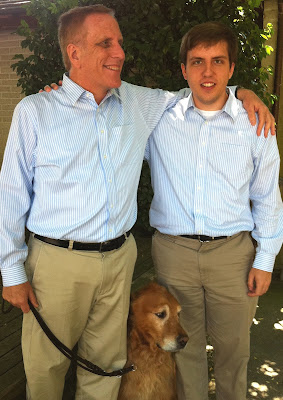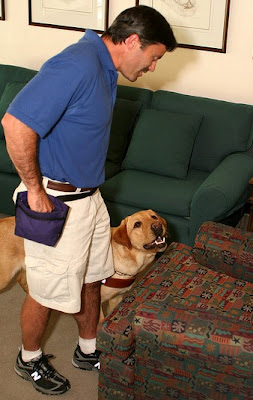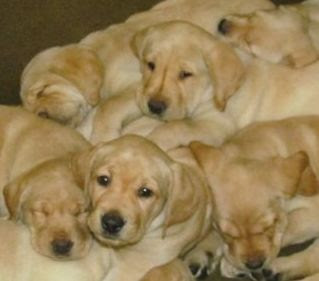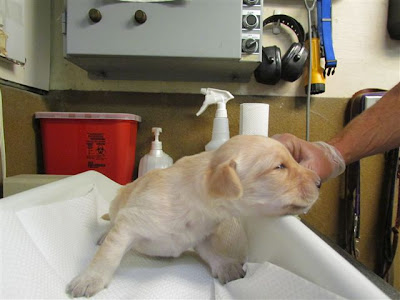Wednesday, August 31, 2011
Monday, August 29, 2011
Saturday, August 27, 2011
My Bucket List

by Mary Andrae
Our daughter raised two Guide Dog puppies through 4-H. I was so inspired by her selfless act and desire to do something for someone else. Needless to say, the first item on my "Bucket List" after retirement was to raise a puppy.
I must say, I was not prepared for just how much I would benefit from raising a puppy. Persia has changed my life. At the grocery store, church, or anywhere we go, Persia is a magnet, drawing people to us. Although I am an introvert, with her I am thrust into the position of meeting new people, answering questions, and informing people about the wonderful work done by Guide Dogs for the Blind.
Persia and I recently completed a 50-hour caregiver class through my church. Together, we now visit an elderly widow. Persia must have been paying close attention in class because she is the most kind and loving caregiver. She brightens this lady's day, as she does with everyone she meets.
We are beginning to realize how much sweet Persia will be missed by her many friends when she returns to GDB in September, and certainly our house, our family and our hearts will feel the loss. This little yellow Lab's impact on us has been tremendous. But we know she will have even more of an impact on the lucky person whose "eyes" she will someday become.
Has raising a Guide Dog puppy had an impact on your life?
Friday, August 26, 2011
Driving Mr. Will

by Morgan Watkins, GDB Acting President and CEO
Late one Friday afternoon, a few weeks ago, I told my son that if he picked me up after work, I would take us out to a nice dinner. Richard, being a 23-year-old student working as an intern at a local software firm, was more than happy to accept a free meal. So, shortly after 5 p.m., he showed up, ready for Dad to foot the dinner bill. Unfortunately, I had some last minute business that needed my attention before the weekend and I let him know that I would be tied up for an hour or more. I offered to pay for some fast food if he wanted to go and pick it up.
My Guide Dog Will had come out from under my desk to visit with Richard. Those two fellows are close buddies.
“Dad, can I take Will with me?”
I said that he could. I quickly took Will out for a little break on the lawn. It is important to note that our HR director saw Will and me walk by her office at this time.
After coming back in, I took the harness off of my dog and Richard grabbed the leash. Richard walked outside, let Will hop into the back of his car and then Richard took off to pick up our drive-thru meal.
At this same time, our GDB HR director spots Will and me walking outside. She sees me open the back seat of a car, let Will hop in, and then she sees me walk around the car and get in the driver’s seat. She knows that I drove a very long time ago, but this doesn’t make sense. And, then she sees me, with my Guide Dog in the back, drive away. She is stunned, and knows that something is very wrong with the picture she is seeing. It takes many seconds before it clicks that she was looking at Richard, who is about my height and similar in appearance.
I love the fact that our team can laugh and share fun stories like this, and still make a difference in so many lives. The camaraderie we enjoy with each other, and with our volunteers and graduates, makes this a very special place to work. We are all so very fortunate.
Yes, all is good in Guide Dog Country.
Wednesday, August 24, 2011
Tuesday, August 23, 2011
Click Click!

GDB puppy raisers got a glimpse of what goes on behind the scenes when their puppies are trained to become Guide Dogs. Instructor Todd Jurek leads a demo of GDB Clicker Guide Dog Training on Fun Day in this two-part video on our YouTube Channel.
Part I
Part II
Monday, August 22, 2011
The world's largest aquarium
 The world's largest aquarium is located in Atlanta, Georgia, USA at Pemberton Place. It is a water home for more than 120 000 animals of 500 different species with more than 8.5 million gallons (31,000 m³) of marine and fresh water. The most famous aquarium's specimens include four young whale sharks, four manta rays, and four beluga whales.
The world's largest aquarium is located in Atlanta, Georgia, USA at Pemberton Place. It is a water home for more than 120 000 animals of 500 different species with more than 8.5 million gallons (31,000 m³) of marine and fresh water. The most famous aquarium's specimens include four young whale sharks, four manta rays, and four beluga whales.The world largest aquarium is funded mostly by a donation from Home Depot co-founder Bernie Marcus. He donated more than $250 million. The aquarium was built on a 20 acre (81,000 m²) site north of Centennial Olympic Park in down-town Atlanta. Marcus credited his 60th birthday dinner at the Monterey Bay Aquarium in 1990 among the inspirations behind his desire to build an aquarium in Atlanta.
Sunday, August 21, 2011
Friday, August 19, 2011
Ants - life underwater | BBC wildlife
Do you know that:
Ants started farming long before human beings.
Ants are capable of carrying objects 50 times their own body weight with their mandibles.
Around 700,000 members can be found in a typical Ant colony of Army ants.
Sometimes soldier ants use their heads to plug the entrances to their nests and keep intruders from gaining access.
Ants lived alongside the dinosaurs over 100 million years ago.
Certain ant species defend plants in exchange for food and shelter.
Every ant has two stomachs. In the first one it stores food for itself and in the second it stores food that is to be shared with other ants.
The total biomass of all the ants on Earth is roughly equal to the total biomass of all the people on Earth.
The ants have very strong legs. They help them to run very quickly.
 Ants sometimes herd or tend to insects of other species, like aphids or leafhoppers.
Ants sometimes herd or tend to insects of other species, like aphids or leafhoppers.The common Black Ants and Wood Ants have no sting, but they can squirt a spray of formic acid.
Ants are capable of enslaving other ants, keeping them captive and making them do work for the colony.
The average life expectancy of an ant is 45-60 days.
Some ants form "super-colonies,". These are massive communities of ants that can stretch for thousands of miles.
If a worker ant has found a good source for food, it leaves a trail of scent. The other ants follow those scent trails laid by scout ants to gather food.
At night the worker ants move the eggs and larvae deep into the nest to protect them from cold.
Thursday, August 18, 2011
I'll Bet You Didn't Know

by Rebecca Hornick, GDB Dog Placement Coordinator
There are so many interesting things to know about Guide Dogs for the Blind -- innovations in training, health tips from our veterinarians and fun stories about raisers and grads. In this post, I’d like to feature a core group of dedicated employees in the San Rafael Kennel Department.
Beyond keeping the kennels immaculate and feeding the dogs, our Kennel staff are experts in many aspects of canine care. It is not an exaggeration to say that senior members of our Kennel staff have more whelping experience than do most veterinarians. The staff is on duty 24 hours a day, 7 days a week. Aside from caring for the dogs that are whelping and nursing, they check on all the dogs in their care throughout the kennel: boarding dogs; surgical recovery dogs; young puppies and others that may need feeding, medications and treatments throughout the night. On-call veterinarians can sleep soundly knowing they can count on the expertise of Kennel staff to manage the most challenging medical situations with little or no assistance.

After the Breeding Department staff makes the selections of the dogs that will be bred, it is primarily the Kennel staff who conducts these scheduled breedings. There are at least two staff members present for each breeding to ensure all goes well and record any details that will affect future breedings. The Kennel staff knows our breeder dogs well because they are responsible for their health and wellbeing before, during and after conception. It’s not uncommon for staff to greet these dogs by name as they saunter down the hallway with their breeder custodians in tow. I recall feeling comforted when, years ago, I dropped off my own breeder at GDB and she greeted each staff member along the way with a wag and smile of recognition.

Kennel staff is present at each whelp to detect any subtle signs of trouble. Once the pups are born, staff assesses them daily during their first months of care. Our Veterinary staff can attest to their in-depth medical knowledge – the two departments work hand-in-hand. By paying close attention to symptoms that might normally go unnoticed, Kennel staff experts utilize the experience they have gained by caring for hundreds of our dogs and alert the veterinarians to unusual cases that may require further medical attention.

They also oversee a lot of healthy dogs who come in to board each year while their caretakers are away from home. They engage the minds and bodies of these active dogs while boarding through our Kennel Enrichment Program to alleviate the dogs’ boredom. These activities include: daily dog walks, canine cuddling programs for physically challenged dogs that cannot go for invigorating walks, hanging toys in the outdoor and indoor runs, play structures to climb on and stuffed frozen Kongs (also called “pupsicles”) which are a much loved treat and activity all rolled into one delicious morsel!
Kennel staff also has the responsibility of managing the in-home Litter Raiser Program, processing all dog food orders for the hundreds of dogs on campus (as well as GDB staff dog food orders) and receiving all incoming phone calls after hours (whether they involve a medical emergency, lost dog or random question that happens to come in during the middle of the night). They conduct hands-on training programs for new dog walkers and foster care providers (so they can comfortably walk and care for their four-legged charges with confidence and skill).
The variety of unique challenges and educational opportunities may be among the factors that contribute to this staff’s amazing longevity. The 14“senior” staff (10+ years) have 258 combined years among them -- that’s a LOT of experience when you think about all they have seen and done in those years. Clearly, there’s a lot more to the job than just scooping and hosing. Of course, they get to receive lots of doggy kisses to help keep them motivated through the busiest of times as they do their fulfilling and important work for in support of GDB’s mission.

I am happy to sing the praises for this dedicated and humble core group of staff. Their hard work reminds us there’s a lot going on behind the scenes to make GDB a success.
Wednesday, August 17, 2011
March of the Penguins and "Flying Penguins"
Do you know that:
Penguins can adapt to various climates.
They waddle while walking.
Baby penguins have soft feathers. Those feathers are known as down.
Penguins live in large colonies called rookeries.
Penguins spend most of their lives in water.
Penguins have the ability to walk faster than humans.
Penguins use body language to communicate with each other.
They don’t fear humans but are endangered by oil spills, water pollution, and the over harvesting of ocean fish.
Penguins have more feathers per square inch and that keeps them warm in frigid waters.
Penguins are very social creatures.
Their body is insulated with a thick layer of blubber that keeps them warm.
Penguins can hold their breath under water - for about 20 minutes.
 Rockhopper penguins have very loud calls and are very noisy.
Rockhopper penguins have very loud calls and are very noisy.Penguins are dresses in classic white and black. They are counter-shaded for camouflage.
The baby penguins count on their parents for food until they grow up with waterproof juvenile feathers.
Penguins can leap out of water while swimming.
They pick up stones and store them in their crop. This helps them to float when they are in water.
Penguins can control their blood flow through the amount of fat in their bodies.
Here is a very funny video – BBC: Penguins April fool joke:
Tuesday, August 16, 2011
Monday, August 15, 2011
The Komodo dragon
Do you know that:
People believe that there are now only 4 thousands Komodo dragons left on the planet.
The Komodo dragon has a long life expectancy of about 50 years.
There are about 4 times as many male Komodos as females, in the wild.
Komodo dragons are easily confused with crocodiles. They are called the “Ora” or “land crocodile” by locals.
The Komodo dragon is the heaviest and largest living lizard in the world.
Komodos are able to grow as long as 10 feet and weigh more than 300 pounds.
Komodo dragons eat almost any kind of meat.
Komods are able to see prey and other objects as far as 985 feet away.
These dragons can run just as fast as humans can - up to 11 miles an hour. They just tire quickly.
 There was an old belief in China that the tail of a dragon, when ground into powder, was a powerful medicine. Some believed that it could even stop a person from growing old!
There was an old belief in China that the tail of a dragon, when ground into powder, was a powerful medicine. Some believed that it could even stop a person from growing old!The Komodo dragon is able to eat almost 80% of its weight in one meal.
Komodos hunting strategy is very simply. They will go for the feet, and bring down the prey. Then the Komodo dragon will rip its victim to pieces.
The Komodo dragons ancestors date back over 100 million years.
Komodos mouth saliva contains a host of deadly bacteria.
A Komodo will go through about 4 or 5 sets of teeth in his life.
These dragons have no natural enemies. The greatest threat they face is from other dragons, and humans.
Once a female dragon lays her eggs, she never comes back to check up on them.
Young Komodo dragons are able to climb trees, to help protect them, and to find food.
Hedgehogs - cute and funny animals
Do you know that:
Hedgehogs possess incredible sense of smelling.
Hedgies can be found in woods, parks, farmland, gardens.
All hedgehogs are capable of swimming and climbing trees.
When hedgies are born, their spines are very short and very soft.
Hedgehogs eat mice, birds, worms, slugs, adore eggs and various plants and fruits.
Hedgehogs Latin (scientific) name is “Erinaceus europaeus”.
 Hedgehogs are nocturnal animals. Also they hibernate from November to the end of March every year.
Hedgehogs are nocturnal animals. Also they hibernate from November to the end of March every year. Strangely hedgies live up to 3 years in the wild and in captivity – up to 10 years.
Hedgehogs prefer leading solitary lives.
Hedgehogs are very loud animals. They make various rather loud sounds (sneezing, snorting, purring, squealing, etc.).
Hedgies are born with closed eyes.
Many people posses hedgehogs as pets. Hedgies are very interesting to look at, they are not aggressive and have no odour.
Saturday, August 13, 2011
Kangaroos playing with their mother
Do you know that:
- Baby kangaroos, regardless of sex, are always called Joeys. Male kangaroos are known as Jacks, Bucks or Boomers. Female kangaroos are known as Jills, Does or Flyers.
- Kangaroos can survive months without drinking water. Also, very often when they need water, kangaroos will dig their own water wells to find it.
 - The female kangaroo will give birth to a new Joey just when it is time to eject the older kangaroo from her pouch. During the time of transition, she will simultaneously produce two different types of milk for the different needs of her young kangaroos. Each Joey knows which milk is theirs and will only nurse from the appropriate one.
- The female kangaroo will give birth to a new Joey just when it is time to eject the older kangaroo from her pouch. During the time of transition, she will simultaneously produce two different types of milk for the different needs of her young kangaroos. Each Joey knows which milk is theirs and will only nurse from the appropriate one.- Joeys can be seen peeking from their mothers pouch. The "two-headed" kangaroos shocked the early Australian explorers. When they returned to Europe they told strange stories about the “two-headed” monster but other folks rarely believed them.
In the end – here is a hilarious video of Remi Gaillard playing funny kangaroo:
Friday, August 12, 2011
Thursday, August 11, 2011
Breeders Digest, June 2011

Here are the announcements for puppies born and breeder dogs named at GDB during June 2011. Follow the links below to see pictures!
Litter Announcements
Labrador Retrievers
- 6/2/11 Forte x Willa – 5 males, 2 females – litter letter “C”
- 6/3/11 David x Blossom – 3 males, 5 females – litter letter “K”
- 6/7/11 Marino x Rumor – 3 males, 4 females – litter letter “J”
- 6/9/11 Alonzo x Mamie – 4 males, 1 female – litter letter “L”
- 6/17/11 Alonzo x Azul – 3 males, 4 females – litter letter “M”
- 6/18/11 David x Chenille – 3 males, 3 females – litter letter “P”
- 6/18/11 Simon x Harbor – 3 males, 2 females – litter letter “R”
- 6/24/11 Hurley x Sarita – 3 males, 4 females – litter letter “V”
- 6/25/11 Marino x Pomona – 4 males, 2 females – litter letter “S”
- 6/30/11 Alonzo x Delhi – 2 males, 2 females – litter letter “N”
Golden Retrievers
New Breeders
Labrador Retrievers
- Beatrice – raised in WA
- Belize – raised in CA
- Honor – raised in CA
- Lacey – raised in CO
- Leche – raised in CO
- Stockholm – raised in CA
- Wanda – raised in UT
Golden Retrievers
- Franklin – raised in WA
- Jonathan – raised in CO
Wednesday, August 10, 2011
Racoon and dog playing

Another cool raccoon and dog video could be watched here:
Raccoon Vs Dog
This video sharing is disabled, that's why I can not embed it and just provide the link to it. But it shows a very cute dog and raccoon playing and "wrestling" each other.
Tuesday, August 9, 2011
Monday, August 8, 2011
Subscribe to:
Comments (Atom)